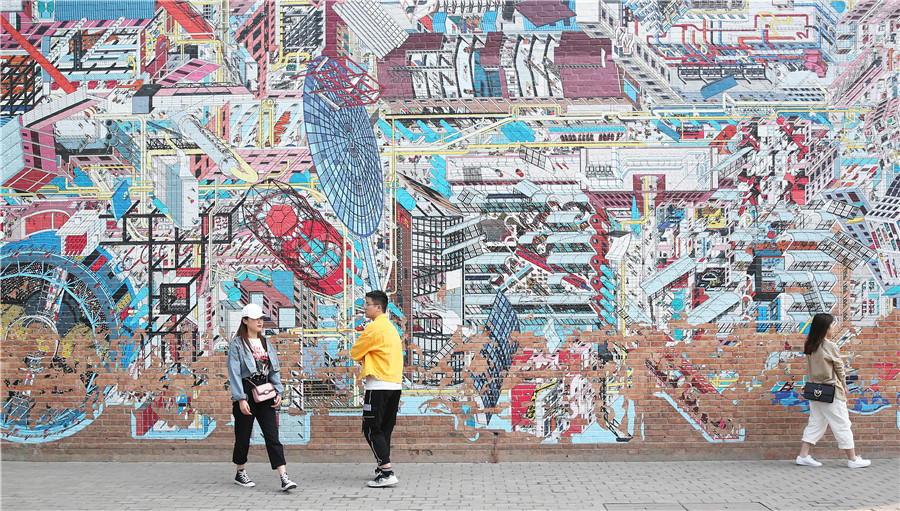The smokestack that rises behind the red, refaced stucco facade of the UCCA Center for Contemporary Art in Beijing's 798 Art Zone is a remnant of the factory that originally stood there and points to the area's industrial roots.

Pedestrians pass by graffiti in Beijing's 798 Art Zone, which has become an international contemporary art hub, on April 23. (Photos: China Daily)
The ground-floor walls of the newly renovated museum have been demolished, leaving only supporting columns and glass wraparounds that allow visitors to see the various activities throughout the complex.
"It's about making more connections, about tearing down walls," said Philip Tinari, the museum's director and CEO.
The latest developments at the museum, which is in the heart of the art zone, reflect the area's transformation from artists' enclave to international arts hub.
For many in the arts community, the zone is now considered a beacon of the rise of Chinese contemporary art's global significance. The celebrated art district is also becoming symbolic of the growing confidence and influence of Chinese cultural identity.

Visitors at UCCA Center for Contemporary Art in Beijing.
The zone "started out as a place where artists in Beijing could get access to affordable studio and display spaces," said Paul Gladston, professor of contemporary art at the University of New South Wales in Sydney, Australia.
"798's status as an international art hub came about largely as a matter of happenstance and location rather than careful long-term planning," he said. "It has, though, spawned numerous government and privately supported art districts across China that, among other things, support urban development and the development of cultural industries."
However, he said, "The symbolic significance of 798 as a conspicuous marker of China's renewed cultural openness nevertheless remains."
Since it first gained prominence for its community of artists in the early 2000s, the 798 Art Zone in Beijing's Chaoyang district has grown to cover nearly 300,000 square meters, including more than 500 art studios, galleries, institutions and related establishments from 25 countries and regions, according to the local administrative committee.
The increasing commercialization of the zone, with restaurants, cafes, bookshops and retail outlets, has also helped make it one of Beijing's top attractions.
The zone has adopted a collaborative approach, described as government-guided and enterpriseoriented, to develop its art institutions. The UCCA's Tinari said this has led to the successful management of a cultural district, which, he added, is the envy of many Chinese cities that are trying to repurpose their own industrial infrastructure.
Wang Yanling, head of Beijing Sevenstar Huadian Science and Technology Group Co, which runs the zone, said 798's hosting of the highest concentration of contemporary art institutions in China offers an unmatched platform for Chinese influence on the field's international presence. He said Beijing is now one of the world's top five cities for contemporary art.
The zone attracted more than 8.08 million visitors from home and abroad last year alone, including heads of state and other dignitaries, Wang said.
"The 798 Art Zone is a cultural pillar of support, with the growing global influence of Chinese contemporary art and its rising role in the dialogue between East and West," he said.

Visitors take photos at Beijing's 798 Art Zone.
Tinari, whose UCCA center has grown to about 1,400 staff members since its founding in 2007, said the zone plays a key role in the global impact of Chinese contemporary art.
At the annual Art Basel international art fair, for example, more than 60 percent of Chinese galleries that present are from the zone, he said.
"If you look at the global art market, China actually has a very huge piece of the pie, right there with some of the major international centers," Tinari said. "What's interesting about Chinese contemporary art is that it's not the flavor of the month anymore. It definitely went through that period, in the late 1990s and early 2000s (but) that's not where we are anymore."
Gladston, the professor of contemporary art, has written extensively on the subject. "Two of the biggest changes in China's contemporary art scene in recent decades are, on the one hand, the establishment of contemporary Chinese art as a globally significant phenomenon, culturally, socially and politically, and, on the other, an increasing confidence among Chinese artists in asserting specifically Chinese cultural identities," he said.
One of that phenomenon's key issues, he added, is "the associated shift of cultural, economic and political power from the North and West to the East and South as part of globalization".
The role of Chinese art in expanding the country's influence has also "certainly helped to reinforce the standing of Chinese culture on the world stage and the perception that Western cultural power is in some sense waning", he said.
Qiu Zhijie, dean of the School of Experimental Art at the China Central Academy of Fine Arts and professor at the School of Intermedia Art at the China Academy of Art, said Chinese contemporary artists who have had a major impact via international art events-such as Cai Guoqiang, who won the 48th Venice Biennale International Golden Lion Prize-are still concentrated in a select group.
"Chinese contemporary art collectors, for example, need to look more at the younger, budding artists," Qiu said.
"Still, the 798 zone remains an integral stop for anyone who wants to understand Chinese contemporary art's place in the world," he said.
Zhang Mu, 36, from Sichuan province, has exhibited in various domestic venues but sees the 798 Art Zone as having the leading role in China's contribution to the global contemporary art scene.
"As an international art hub, there may be no better platform than 798," he said.


